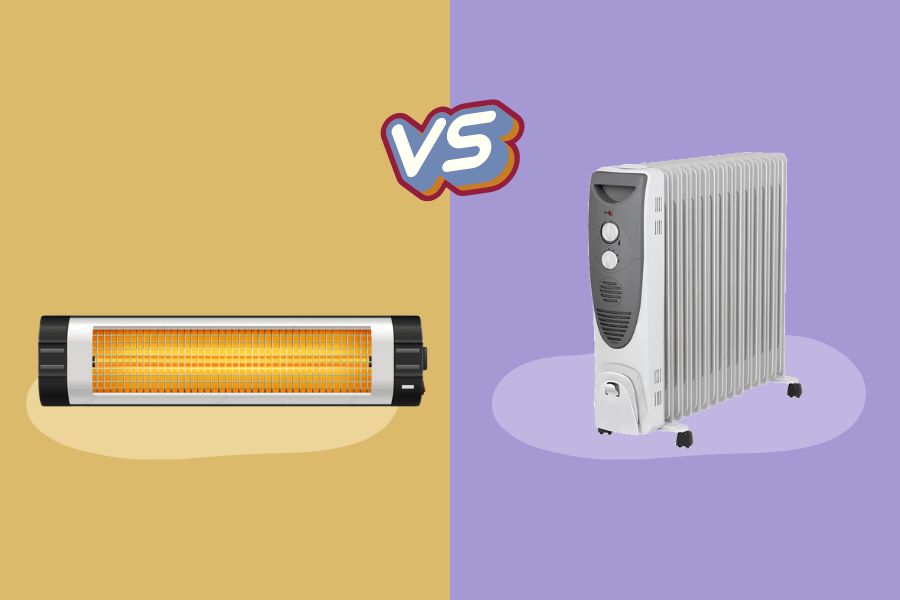Choosing the perfect room heater can be tricky in our pursuit of comfort. Two popular types dominate the market – infrared vs oil-filled heater. But how do you decide between an infrared and oil-filled room heater? Let’s break it down.
An infrared heater emits infrared radiation, providing directional heat and quick heating. On the other hand, an oil-filled heater heats up an oil-filled radiator. The warm oil transfers heat to the oil-filled heater’s metal body, radiating the heat evenly into the room.
So, which heating element suits you best? Let’s embark on this journey to find out!
Introduction
Welcome to the world of room heaters! Here, we compare two significant types – infrared and oil-filled room heaters. Ready to find out which is right for you?
Understanding Infrared and Oil Filled Heaters
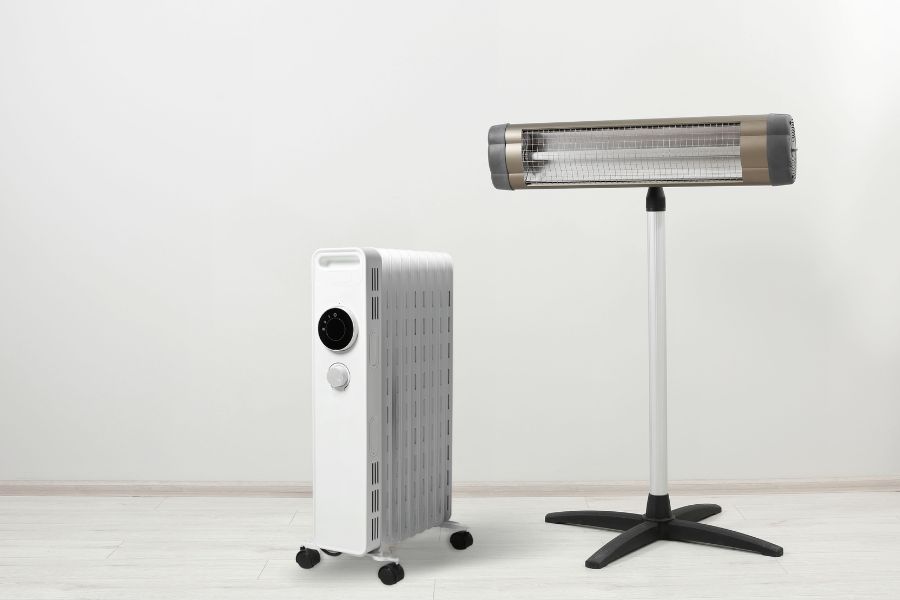
An infrared heater, also known as a radiant heater, converts electricity into radiant heat. This heat warms up objects and people directly. The heating speed? It’s fast. You feel warm as soon as the infrared heat hits you.
What’s unique about these radiant heaters is the heating element – it emits heat through infrared radiation, giving directional heat. On the other hand, there’s the oil-filled heater. The name might be confusing. You don’t need oil for this heater.
So how does it work? The oil inside the oil filled heater first gets heated by an electric current. The hot oil heats the metal body of the heater. This heat then gets transferred to the surrounding air. This process creates a heat reservoir in the oil-filled room heater, providing continuous heat.
While an infrared heater provides quick heating, an oil-natural gas-filled heater ensures your room stays warm for longer. It retains heat even after being turned off.
A Deep Dive into Infrared Heaters
Infrared heaters are intriguing devices, aren’t they? They’re unique, they’re efficient, and they have a lot to offer. Let’s dive deeper into their world.
The Functioning of Infrared Heaters
The infrared heater operates quite differently from traditional room heaters. The secret lies in infrared radiation. This heating element produces radiant heat, and it works pretty cool. Rather than heating the air, it emits heat directly onto objects and people.
It’s like the warm feeling you get from the sun on a chilly day. You can find this same infrared heating element in some outdoor spaces, perfect for those late-night barbecues!
Now you might be thinking, does that mean it doesn’t heat the whole room? Not at all! It’s all about the infrared radiation and the fan heater’s direction. Wherever the fan heater is pointed, you’ll find the warm air. Quick heating is a big plus with infrared heaters; no waiting around in the cold.
Key Features of Infrared Heaters
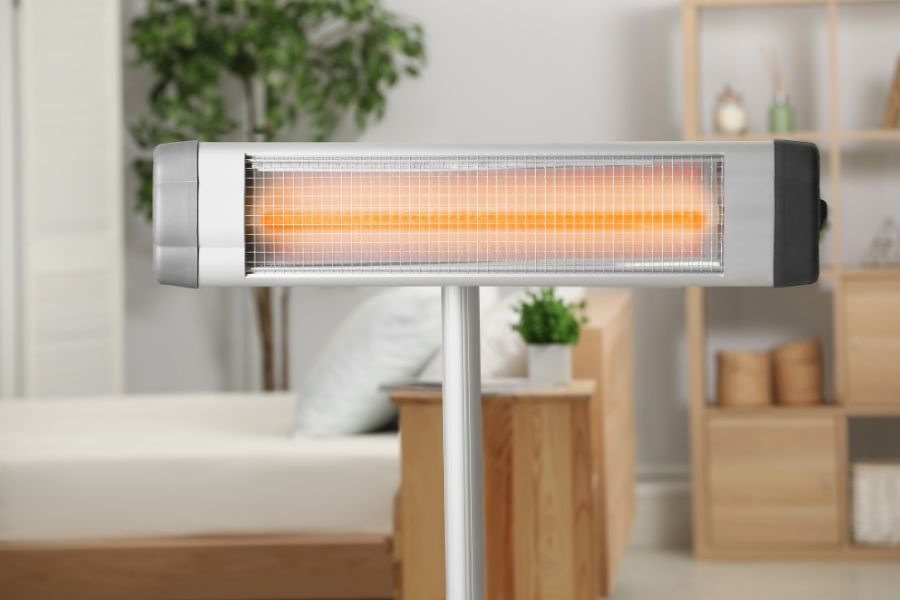
One top feature of infrared heaters is energy efficiency. They convert electricity into heat with little loss in the power conversion and heating stage. This means lower energy bills for you, and who doesn’t love that?
Safety is another strong point. Many infrared heaters have overheat protection and tip-over protection. Some ceramic heaters even come with a remote control for convenient heat adjustments.
Did you know those infrared heaters also promote healthier air? Unlike other heaters, they don’t dry out the air, providing a more comfortable environment.
Lastly, the silent operation of infrared heaters is a bonus. There’s no fan, just quiet, quick heating for your comfort.
In the battle of infrared vs oil heaters, infrared vs oil-in heaters surely bring some intense arguments. Stay with us as we explore the world of oil-filled heaters next!
Unpacking the Intricacies of Oil-Filled Heaters
After exploring the world of infrared heaters, it’s time we unpacked the secrets of oil-filled heaters.
How Oil-Filled Heaters Work
Don’t be fooled by the name; oil-filled heaters don’t actually burn oil. The oil is a heat reservoir that retains warmth.
Here’s how they work: The system’s electric heaters and heating elements heat up the oil inside. This hot oil, in turn, heats the metal body of the heating element of the heater. From there, it radiates warmth into your room.
Oil-filled heaters work on a principle known as convection heating. The heat rises from the oil heater into the cold air, warming your room evenly. It’s like the gentle warmth you feel in a sunny room.
Despite the gradual heating stage of oil heaters, it gives off continuous heat once the oil heater gets going. Leave an oil heater overnight, and you’ll find your room cozy in the morning!
Key Features of Oil-Filled Heaters
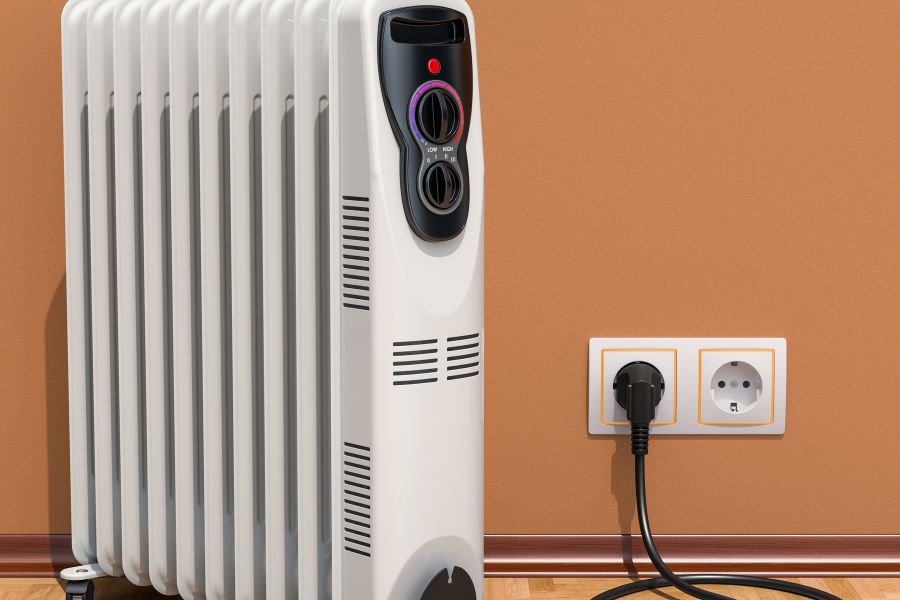
Oil-filled heaters are energy efficient. Once they’re hot, they keep emitting heat even without electricity. That’s a definite plus on the energy bills.
Safety measures are also crucial with these heaters. They usually have a safety feature that turns the heater off if it overheats.
Oil-filled heaters’ big win is their ability to heat large spaces. While they take longer to warm up, they retain heat very well. This makes them ideal for heating larger rooms or areas.
Lastly, they operate silently. There’s no fan in these heaters to make noise, only the soft hum of warm air spreading throughout the room.
Stay tuned to explore the exciting head-to-head comparison of infrared vs oil-filled heaters. What’s going to be the best fit for your needs? Let’s find out!
Comparing Infrared vs Oil Heaters on Heating Capacity
In the battle between the infrared heater vs oil heaters, the heating capacity of the infrared heater is a key factor. Let’s see how they stack up.
Heat Distribution in a Large Room
When heating a large space, the type of heater you choose matters. For instance, an oil-filled radiator uses convection heaters to warm up the room. This means the hot air rises and cold air gets drawn in. It’s a cycle that eventually warms the whole room evenly. If you’re in a large space, it’s a good fit.
Infrared heaters, on the other hand, work differently. They emit radiant heat, heating objects and people directly. The radiant heaters don’t spread around the room in the same way. It’s more like a spot heater.
It warms up the area directly in front of it. But, if the wind immediately blows, it can affect the heat direction.
Heating Speed of Infrared and Oil Heaters
Infrared heaters convert electricity into heat almost instantly. As soon as you turn it on, you’ll feel the warmth. It’s fantastic for quick heat. Want to warm up fast? An infrared heater might be your best bet.
Oil heaters take a bit more time. They need to heat the whole oil heater first, which then heats the metal body of the space heater; the oil heater heats first. But once they’re hot, they stay warm for a long time. They’re slow to start but great for continuous heat.
Energy Efficiency: Infrared Heaters vs Oil Filled Heaters
It’s a contest of power. Not just heat but the ability to save energy. Let’s dive into the energy efficiency of infrared heaters and oil-filled heaters.
Power Conversion Stage in Heaters
Infrared heaters are stars when it comes to power conversion. They convert electricity into heat directly, with almost no loss. You flick the switch; the infrared heater emits heat. Simple, efficient, and fast. Plus, they only heat what needs to be heated, not the air.
This way, they use less energy. But what about oil-filled heaters? They work differently. The electricity heats the oil heater first, and then the oil heaters heat the room. It might sound less efficient, but it’s not.
Once they’re hot, they can emit heat for hours without consuming more electricity. That’s an energy-saving win!
Retaining Heat: A Battle of Metal Body vs Oil Reservoir
Heat retention is where oil-filled radiators shine. The oil in these heaters acts like a reservoir, holding onto the heat and releasing it slowly over time. This means they keep your room warm long after you switch them off. It’s an effective way to heat large spaces.
Infrared heaters? They heat quickly but cool down too rapidly. Once you switch them off, the heat vanishes fast.
Both heaters have their strengths. The choice between a quick-heating infrared heater and a slow, continuous-heat oil-filled heater depends on your needs. Next, we’ll explore safety measures in these heaters. What features keep you safe while you stay warm? Let’s find out!
The Safety Measures in Infrared and Oil Heaters
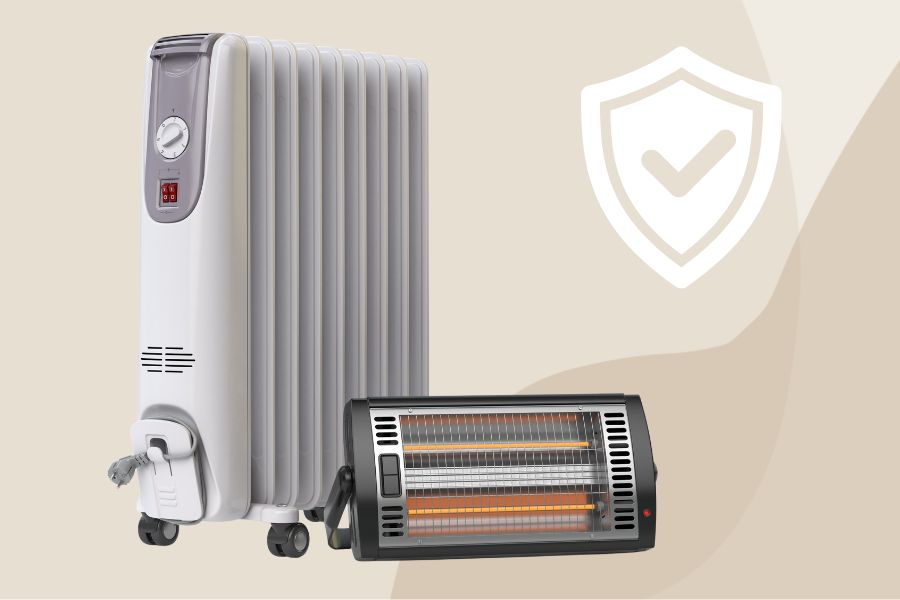
Keeping warm shouldn’t be a risky business. Safety in space heaters is a crucial topic. Let’s talk about the safety measures in infrared and oil-filled space heaters.
Overheat Protection and Tip-Over Safety
Infrared heaters come with a built-in safety feature: overheat protection. If the infrared heater gets too hot, it automatically shuts off. It’s a fantastic feature that saves energy and prevents fires.
But wait, oil-filled heaters have this feature too! If the oil heater heats up and gets too hot, it will also shut the oil heater off. This feature makes both types of heaters safer to use.
Another crucial safety measure is tip-over protection. If you accidentally knock the space heater over, it can be a fire hazard. But most modern space heaters, both infrared and oil heaters, are designed to shut off if they tip over. Safety first!
Infrared heaters use coils that heat up with a bulb and use infrared radiation to heat up objects or surfaces in the area. This heat does not take long to heat up space; the energy is similar to how sunlight heats up objects it hits.
It heats up fast, and the heat cools off when the heater is turned off. It provides quick heat-up in a zone if that is what you prefer.
What Is an Oil-Filled Heater?
The oil-filled heaters are longer units that look like radiators. The heaters are completely closed and have fins or columns on them. These fins heat up because there is an oil reservoir in the unit that circulates the unit.
The oil takes a little longer to heat up, but it’s a more consistent heat. It also slowly cools down since it takes longer for the oil to cool itself once it’s turned off. This unit warms the air around it, giving it a warm environment in the heating area. The fins are warm to the touch but should not be hot or burn.
They are small, portable, use electricity, and the oil does not need replenishment. They are also one of the quietest units to have.
Infrared vs Oil Heater
The significant difference is in the way they heat the surrounding space. Infrared heaters heat surfaces and objects around them. They provide quick heat to surfaces near them.
In contrast, oil-filled heaters heat the air around them. They take time to heat the space and give more constant heat. They also stay warmer after being turned off since the oil takes longer to cool down.
Size
The oil-filled heater is standalone with wheels and looks like a radiator but is space efficient, and the infrared is more boxed-shaped. It also comes in a standalone for the fireplace. Both are good for space efficiency.
Be sure to measure your space to ensure enough room and clearance around the heater.
Portability
The ability to move your heater around from room to room may be a big selling point for you.
It’s not a surprise that an oil-filled heater can be heavy. Many come with wheels attached to help you roll it around. But moving an oil-filled heater up and down flights is no easy task.
Conversely, an infrared heater is typically much lighter and easier to move around.
Design
While it may seem like a petty thing to consider, design is often important. We spend so much time in our homes and want the things around us to bring us joy. A clunky heater may prevent you from enjoying your space, even if it provides ample heat.
So, look at the design options for the infrared and oil-filled heaters. You’ll most likely find more variation in the infrared heater options.
Safety
Both heaters are safe, but purchasing one with the UL label on it is best. Make sure your choice has advanced features like thermostat control and automatic shutdown. This is especially important if you leave your oil or infrared heater on overnight.
Heating Capacity
Infrared is used as a heater that can heat up a particular space or room. They can generally heat up a family room or a living area.
The oil-filled heaters heat the air around the heater so they can work well for a small study or bedroom. Check the box for how large of space they can heat. Both units are comparable in room size.
Noise Level
Many heating systems in the home generate some type of noise. My steam heat radiators often hiss, and it’s something I’ve grown accustomed to. When looking for supplemental heat, consider the additional noise that comes along.
An oil filled radiator will make some noise when turning on, like a clicking noise. This is also common on infrared quartz space heaters. Any additional ambient noise should be reviewed, especially if you’re sensitive to noise or need complete silence.
General Price
The average infrared heater with temperature control usually ranges between $100-$200. The average oil filled heaters range between $50-$100.
You can’t go wrong when comparing oil-filled heaters vs infrared heaters. Both infrared and oil-filled heaters are good choices for creating a comfortable environment in the home. Both have excellent features.
Just a tip – you should always be bought with a warranty or a guarantee by the manufacturer.

